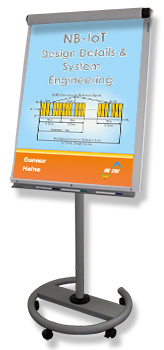 NB-IoT -
Design Details & System Engineering
NB-IoT -
Design Details & System Engineering
[2-day course, Euro 2,350.- (net) per participant]
 Training Course Description
Training Course Description
- This course addresses the needs of technical engineering staff who require deep inside knowledge of the PHY, RF and also upper layers and applications of the NB-IoT technology.
- The course has been designed to meet the requirements of chipset verification, integration and testing staff.
- It is also targeted at technical engineering staff who are supposed to select the optimum IoT-technology for a given application.
- The course starts out with a technical introduction of NB-IoT and depicts the IoT-playground as such with respect to applications and potential QoS-parameterization of an IoT-technology.
- Important alternatives and competing technologies are introduced, namely LoRa, SigFox and the 3GPP-technologies CAT-M1 and EC-EGPRS.
- The next chapter is dedicated to a deep dive into the PHY- and RF-layers of NB-IoT.
- We clarify which coverage to expect from an LTE-cell and by which means NB-IoT achieves a larger and deeper coverage.
- We also clarify how eDRX and PSM operate and how they differ from each other.
- Next we explain in detail the operation of the new channels like the NDPSCH or NPUSCH and the NB-IoT specific random access procedure and system information delivery.
- Another focus in on channel coding in NB-IoT and ARQ/HARQ.
- The next chapter is dedicated to the upper layers and the detailed operation of NB-IoT and we elaborate on the differences between legacy LTE/LTE-A protocols on one hand and the related protocols in NB-IoT on the other hand.
- Two other highlights of this chapter are the optimizations that 3GPP introduced for CIoT in both the user plane and the control plane plus the description as to when and how data can be delivered through the control plane..
- The final chapter may be the target of many students as we conduct a performance analysis of NB-IoT in terms of energy consumption, throughput etc. under different conditions and for different use cases.

Some of your questions that will be answered
- How can NB-IoT provide for the impressive coverage enhancements compared to legacy LTE?
- Why are there 3 different uplink implementations in NB-IoT? Single-tone 3.75 kHz and 15 kHz and multi-tone 15 kHz?
- On which bands does NB-IoT operate?
- How does the OFDMA-grid look like with NB-IoT? Where are the NPDCCH etc. located?
- Why does NB-IoT deploy so-called blind repetitions and what are the implications of using them in terms of throughput rate and latency?
- What are typical battery life times of NB-IoT under different conditions? How to calculate them?
- How can short messages be delivered to NB-IoT UE's without telephone number?
- Which performance in terms of coverage and throughput rate does NB-IoT provide under different conditions?
- Does NB-IoT use turbo coding and HARQ?
- Which new channels does NB-IoT introduce and how do they differ from their wide band ancestors?
- What are the differences between PSM and eDRX and how do both operate?
- How does NB-IoT provide for downlink access to the UE? What are typical delay times?
- To which degree can the operation of NB-IoT be controlled by the UE and by the operator?
- Which new BCCH-messages does NB-IoT introduce and what is their content?
 Pre-Requisites
Pre-Requisites
- The student must possess detailed knowledge about the PHY in LTE, especially on the OFDMA-grid and its layout!
- Detailed knowledge of general RF-issues like link budget, receiver sensitivity is strongly recommended!
 Training Course Target
Training Course Target
- The student is enabled to differentiate in detail NB-IoT from its ancestors in LTE and LTE-A.
- The student can respond to detailed technical questions about NB-IoT and its technical and physical characteristics. This is very important to take considered technology decisions!
- Students are enabled to engineer and analyze NB-IoT equipment in development, test and integration.
 Training Course Duration
Training Course Duration
- 2 days
v1.000
ℹ️ Try out the updated search below!
Search:
More Info:
Detailed ToC of this training course
Schedule of this training course
INACON eBooks
Please have a look at our full offer

